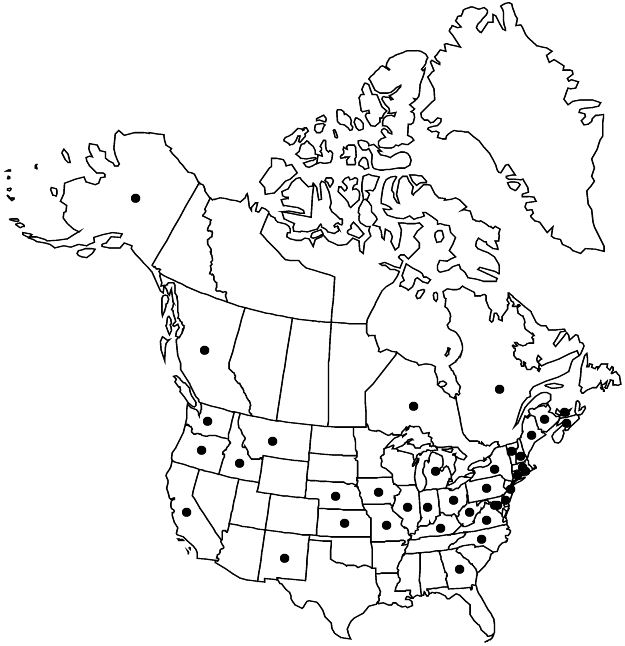Difference between revisions of "Prunus cerasus"
Sp. Pl. 1: 474. 1753.
FNA>Volume Importer |
imported>Volume Importer |
||
| (6 intermediate revisions by 2 users not shown) | |||
| Line 28: | Line 28: | ||
|elevation=0–1000 m | |elevation=0–1000 m | ||
|distribution=B.C.;N.B.;N.S.;Ont.;P.E.I.;Que.;Alaska;Calif.;Conn.;Del.;D.C.;Ga.;Idaho;Ill.;Ind.;Iowa;Kans.;Ky.;Maine;Md.;Mass.;Mich.;Mo.;Mont.;Nebr.;N.H.;N.J.;N.Mex.;N.Y.;N.C.;Ohio;Oreg.;Pa.;R.I.;Vt.;Va.;Wash.;W.Va.;Eurasia. | |distribution=B.C.;N.B.;N.S.;Ont.;P.E.I.;Que.;Alaska;Calif.;Conn.;Del.;D.C.;Ga.;Idaho;Ill.;Ind.;Iowa;Kans.;Ky.;Maine;Md.;Mass.;Mich.;Mo.;Mont.;Nebr.;N.H.;N.J.;N.Mex.;N.Y.;N.C.;Ohio;Oreg.;Pa.;R.I.;Vt.;Va.;Wash.;W.Va.;Eurasia. | ||
| − | |discussion=<p>Cultivars of Prunus cerasus with doubled flowers are used as landscape ornamentals. Most of the commercial sour cherry crop in North America comes from Michigan. Unlike sweet cherry, all widely grown varieties of sour cherry are self-fertile. Bud scales at the bases of the pedicels on flowering and immature fruiting specimens of P. cerasus often have leaflike apices and the inner scales are erect; in P. avium the scales are not leaflike and the inner ones are reflexed or spreading.</p> | + | |introduced=true |
| + | |discussion=<p>Cultivars of <i>Prunus cerasus</i> with doubled flowers are used as landscape ornamentals. Most of the commercial sour cherry crop in North America comes from Michigan. Unlike sweet cherry, all widely grown varieties of sour cherry are self-fertile. Bud scales at the bases of the pedicels on flowering and immature fruiting specimens of <i>P. cerasus</i> often have leaflike apices and the inner scales are erect; in <i>P. avium</i> the scales are not leaflike and the inner ones are reflexed or spreading.</p> | ||
|tables= | |tables= | ||
|references= | |references= | ||
| Line 37: | Line 38: | ||
-->{{#Taxon: | -->{{#Taxon: | ||
name=Prunus cerasus | name=Prunus cerasus | ||
| − | |||
|authority=Linnaeus | |authority=Linnaeus | ||
|rank=species | |rank=species | ||
| Line 53: | Line 53: | ||
|publication year=1753 | |publication year=1753 | ||
|special status=Introduced | |special status=Introduced | ||
| − | |source xml=https:// | + | |source xml=https://bitbucket.org/aafc-mbb/fna-data-curation/src/2e0870ddd59836b60bcf96646a41e87ea5a5943a/coarse_grained_fna_xml/V9/V9_601.xml |
|subfamily=Rosaceae subfam. Amygdaloideae | |subfamily=Rosaceae subfam. Amygdaloideae | ||
|tribe=Rosaceae tribe Amygdaleae | |tribe=Rosaceae tribe Amygdaleae | ||
Latest revision as of 22:58, 5 November 2020
Shrubs or trees, suckering, 30–50(–80) dm, not thorny. Twigs with terminal end buds, glabrous. Leaves deciduous; petiole 10–24 mm, glabrous, usually eglandular, sometimes with discoid marginal glands at bases of blades; blade broadly elliptic to ovate or obovate, 4.4–6(–8) × 2.8–4(–6) cm, base obtuse to rounded, margins doubly crenate-serrate, teeth blunt, glandular, apex acute to abruptly acuminate, abaxial surface glabrous or glabrate, adaxial glabrous. Inflorescences 1–4-flowered, umbellate fascicles. Pedicels 8–37 mm, glabrous. Flowers blooming at leaf emergence; hypanthium tubular-campanulate, 4–6 mm, glabrous externally; sepals reflexed, oblong, 4–7 mm, margins regularly glandular-toothed, surfaces glabrous; petals white, suborbiculate, 10–14 mm; ovaries glabrous. Drupes bright red, globose, 13–20 mm, glabrous; mesocarps fleshy; stones subglobose, not flattened. 2n = 32.
Phenology: Flowering Apr–May; fruiting Jun–Jul.
Habitat: Roadsides, thickets, woodland borders, abandoned fields
Elevation: 0–1000 m
Distribution

Introduced; B.C., N.B., N.S., Ont., P.E.I., Que., Alaska, Calif., Conn., Del., D.C., Ga., Idaho, Ill., Ind., Iowa, Kans., Ky., Maine, Md., Mass., Mich., Mo., Mont., Nebr., N.H., N.J., N.Mex., N.Y., N.C., Ohio, Oreg., Pa., R.I., Vt., Va., Wash., W.Va., Eurasia.
Discussion
Cultivars of Prunus cerasus with doubled flowers are used as landscape ornamentals. Most of the commercial sour cherry crop in North America comes from Michigan. Unlike sweet cherry, all widely grown varieties of sour cherry are self-fertile. Bud scales at the bases of the pedicels on flowering and immature fruiting specimens of P. cerasus often have leaflike apices and the inner scales are erect; in P. avium the scales are not leaflike and the inner ones are reflexed or spreading.
Selected References
None.